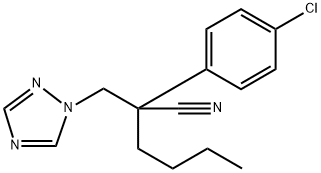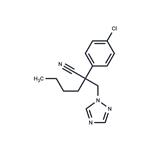
Myclobutanil
- Product NameMyclobutanil
- CAS88671-89-0
- CBNumberCB5190849
- MFC15H17ClN4
- MW288.78
- EINECS922-940-9
- MDL NumberMFCD00144818
- MOL File88671-89-0.mol
- MSDS FileSDS
Chemical Properties
| Melting point | 63-68°C |
| Boiling point | 202-208°C |
| Density | 1.1614 (rough estimate) |
| vapor pressure | 2.13 x l0-4 Pa (25 °C) |
| refractive index | 1.6110 (estimate) |
| Flash point | >100 °C |
| storage temp. | Sealed in dry,2-8°C |
| solubility | Chloroform (Slightly), DMSO (Slightly), Methanol (Slightly) |
| form | Solid |
| pka | 2.30±0.10(Predicted) |
| color | White to off-white |
| Water Solubility | 142 mg/L (25 ºC) |
| Merck | 13,6346 |
| BRN | 7138849 |
| InChIKey | HZJKXKUJVSEEFU-UHFFFAOYSA-N |
| CAS DataBase Reference | 88671-89-0(CAS DataBase Reference) |
| EWG's Food Scores | 3-4 |
| FDA UNII | B6T1JTM6KZ |
Safety
| Symbol(GHS) |
  
|
|||||||||
| Signal word | Warning | |||||||||
| Hazard statements | H302-H319-H361d-H411 | |||||||||
| Precautionary statements | P202-P264-P273-P301+P312-P305+P351+P338-P308+P313 | |||||||||
| Hazard Codes | Xn;N,N,Xn | |||||||||
| Risk Statements | 22-36-51/53-63 | |||||||||
| Safety Statements | 36/37-46-61 | |||||||||
| RIDADR | UN 3077 | |||||||||
| WGK Germany | 3 | |||||||||
| RTECS | XZ5257000 | |||||||||
| Hazardous Substances Data | 88671-89-0(Hazardous Substances Data) | |||||||||
| Toxicity | LD50 in male, female rats (mg/kg): 1600, 2229 orally; LD50 in rabbits (mg/kg): 7500 dermally (Orpin) | |||||||||
| NFPA 704: |
|


